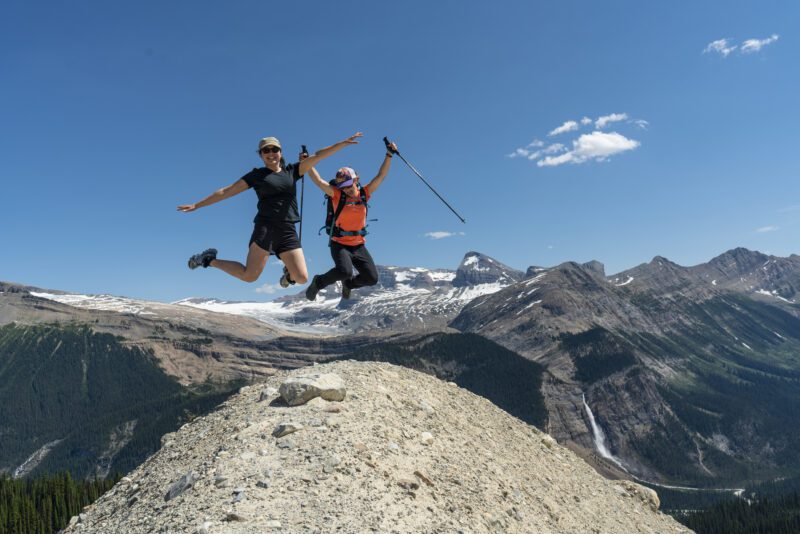 Strap on your hiking boots! Visiting one of Canada’s national parks is a thrilling adventure whether it is your first or your one hundredth visit. The spectacular wilderness, awe-inspiring views, and jewel-toned lakes of the mountain national parks draw millions of visitors every year.
Like any trip, advanced planning will set you up for success and help you tick off those bucket list items with ease. So, let’s talk about what you need to know when touring the Golden Triangle and visiting the mountain national parks.
A national park. What does that mean?
Along your journey through the Golden Triangle, you will pass through 3 separate and unique national parks. Yoho, Kootenay and Banff. Long before park designation, these lands and waters were the traditional territories of Indigenous groups such as the Ktuxnaxa and Secwépemc Nations who stewarded these places.
Starting as early as 1885, park lands were established to preserve and protect the unique and spectacular mountain wilderness so that the landscapes can be enjoyed long into the future. In Canada, national parks are protected under the Canada National Parks Act. The primary goal of Parks Canada is to protect the ecological integrity of the land and waters while allowing visitors to explore, learn, and connect with natural spaces in unique regions across Canada.
What does this all mean? It means, these places are special, and there are certain rules you are expected to know and follow when visiting here that will help protect the incredible wildlife and the unique environment.
Strap on your hiking boots! Visiting one of Canada’s national parks is a thrilling adventure whether it is your first or your one hundredth visit. The spectacular wilderness, awe-inspiring views, and jewel-toned lakes of the mountain national parks draw millions of visitors every year.
Like any trip, advanced planning will set you up for success and help you tick off those bucket list items with ease. So, let’s talk about what you need to know when touring the Golden Triangle and visiting the mountain national parks.
A national park. What does that mean?
Along your journey through the Golden Triangle, you will pass through 3 separate and unique national parks. Yoho, Kootenay and Banff. Long before park designation, these lands and waters were the traditional territories of Indigenous groups such as the Ktuxnaxa and Secwépemc Nations who stewarded these places.
Starting as early as 1885, park lands were established to preserve and protect the unique and spectacular mountain wilderness so that the landscapes can be enjoyed long into the future. In Canada, national parks are protected under the Canada National Parks Act. The primary goal of Parks Canada is to protect the ecological integrity of the land and waters while allowing visitors to explore, learn, and connect with natural spaces in unique regions across Canada.
What does this all mean? It means, these places are special, and there are certain rules you are expected to know and follow when visiting here that will help protect the incredible wildlife and the unique environment.
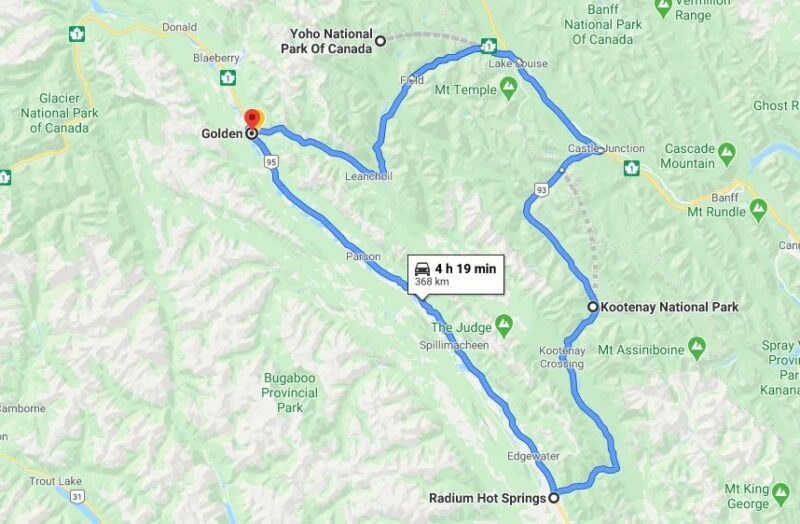 Know before you go.
When considering a visit to the other side of the Rockies, knowing where to go and how to behave will help you maximize your time here and prevent some common pitfalls. Here are some some of our top tips:
Get your Pass: To keep it simple, all visitors to a National Park in Canada must have either a National Park Day Pass, or an annual pass known as a “Discovery Pass”. Admission fees help maintain these places and allow amenities (like interpretive signage and trails) to stay in good repair. A day pass is good for the day you purchased it until 4 p.m. the next day. A discovery pass provides you with unlimited admission to all participating national parks, national marine conservation areas and national historic sites and it is valid for 12 months from the date of purchase! If you will be visiting Parks Canada places for more than 7 days this year, the discovery pass is worth the cost. When touring the Golden Triangle, you can purchase your Parks pass at:
Know before you go.
When considering a visit to the other side of the Rockies, knowing where to go and how to behave will help you maximize your time here and prevent some common pitfalls. Here are some some of our top tips:
Get your Pass: To keep it simple, all visitors to a National Park in Canada must have either a National Park Day Pass, or an annual pass known as a “Discovery Pass”. Admission fees help maintain these places and allow amenities (like interpretive signage and trails) to stay in good repair. A day pass is good for the day you purchased it until 4 p.m. the next day. A discovery pass provides you with unlimited admission to all participating national parks, national marine conservation areas and national historic sites and it is valid for 12 months from the date of purchase! If you will be visiting Parks Canada places for more than 7 days this year, the discovery pass is worth the cost. When touring the Golden Triangle, you can purchase your Parks pass at:
- Tourism Radium Visitor Information Centre
- Tourism Golden Visitor Information Centre
- Any Parks Canada visitor Information Centre, park gate or electronic kiosk
- Online in advance
DYK: all brochures and visitor guides are available for download in advance of your trip. You can also find this information on the Parks Canada App.
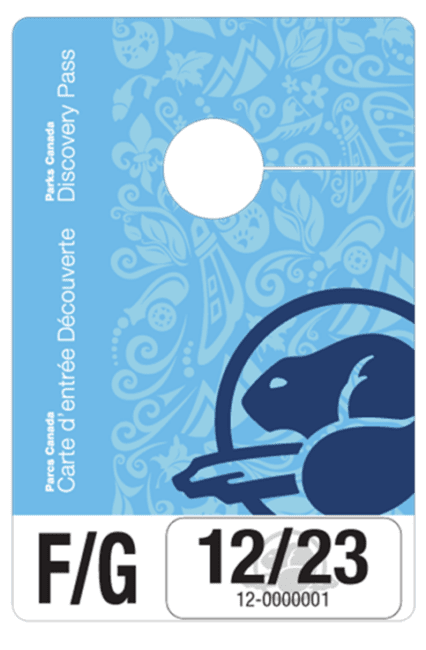 Reserve in advance.
These special places are extremely popular in the summer months (May – October). Access to most trails and day-use areas are first-come first-serve and parking areas can fill quickly. To create some certainty in your trip we recommend booking campsites and guided experiences with as much notice as possible. The Parks Canada Reservation Service is your one-stop shop for front-country and backcountry campsites, glamping accommodations like oTENTiks, and day-use tickets for guided hikes and transit (where offered). Reservations open in January or February most years and are in high demand. Can’t find what you’re looking for? Check back often as cancellations can happen. Also, most locations do have some first-come first-served spots and there are additional accommodators in the Village of Radium, the Town of Golden, and the community of Field.
Closer to your trip, be sure to check the Parks Canada website or contact the Visitor Information Center to find out what locations are open, what conditions to expect, how to prepare, and what services are available before you travel. This will help you select activities that fit your level of skill and knowledge, what gear will be required for your trip, and what accessible options and accommodations are available throughout the park.
Visitor guidelines you might not know about.
We’ve already mentioned this place is special and we need your help to keep it this way. Yoho, Kootenay, and Banff national parks are home to hundreds of species, including grizzly bears, wolves, elk, and more (not to mention all the birds, fish, reptiles, and insects). These animals rely on the unique ecosystem for their survival so protecting it should be a top priority. Here are some things you may not think about when visiting a national park that are extremely important:
Reserve in advance.
These special places are extremely popular in the summer months (May – October). Access to most trails and day-use areas are first-come first-serve and parking areas can fill quickly. To create some certainty in your trip we recommend booking campsites and guided experiences with as much notice as possible. The Parks Canada Reservation Service is your one-stop shop for front-country and backcountry campsites, glamping accommodations like oTENTiks, and day-use tickets for guided hikes and transit (where offered). Reservations open in January or February most years and are in high demand. Can’t find what you’re looking for? Check back often as cancellations can happen. Also, most locations do have some first-come first-served spots and there are additional accommodators in the Village of Radium, the Town of Golden, and the community of Field.
Closer to your trip, be sure to check the Parks Canada website or contact the Visitor Information Center to find out what locations are open, what conditions to expect, how to prepare, and what services are available before you travel. This will help you select activities that fit your level of skill and knowledge, what gear will be required for your trip, and what accessible options and accommodations are available throughout the park.
Visitor guidelines you might not know about.
We’ve already mentioned this place is special and we need your help to keep it this way. Yoho, Kootenay, and Banff national parks are home to hundreds of species, including grizzly bears, wolves, elk, and more (not to mention all the birds, fish, reptiles, and insects). These animals rely on the unique ecosystem for their survival so protecting it should be a top priority. Here are some things you may not think about when visiting a national park that are extremely important:
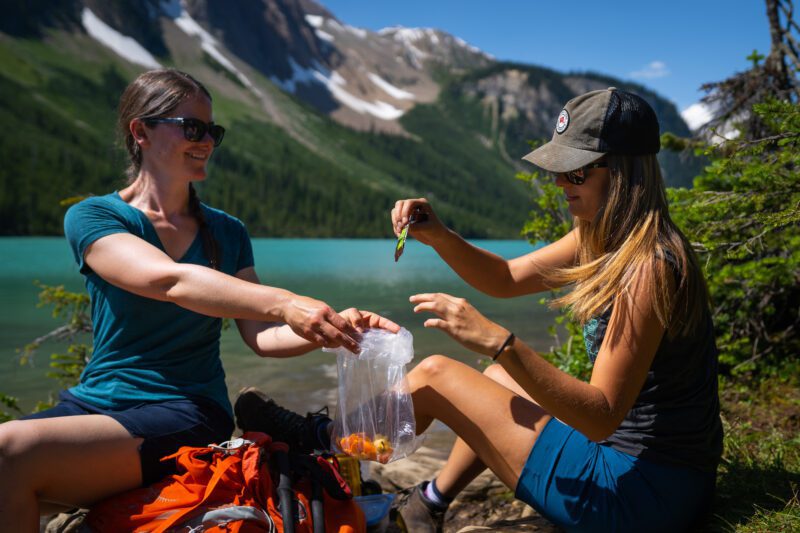
- Dispose of Garbage – We know you know this one, but did you know “garbage” includes things like apple cores and banana peels? Even though many items will eventually compost, they are not native to this landscape and can cause harm to some of the creatures that live here. Orange peels take 6 months to decompose, and cigarette butts can take up to 10 years! With 450,000 km2 of protected land, there’s no way we can pick up after everyone!
- Never Feed Wildlife – Wildlife can quickly find any food, scented items, or garbage that is left unattended. When they eat these unnatural foods, fauna learn to approach people for an easy meal. This can result in aggressive behavior that puts both people and wildlife at risk of being hurt or killed.
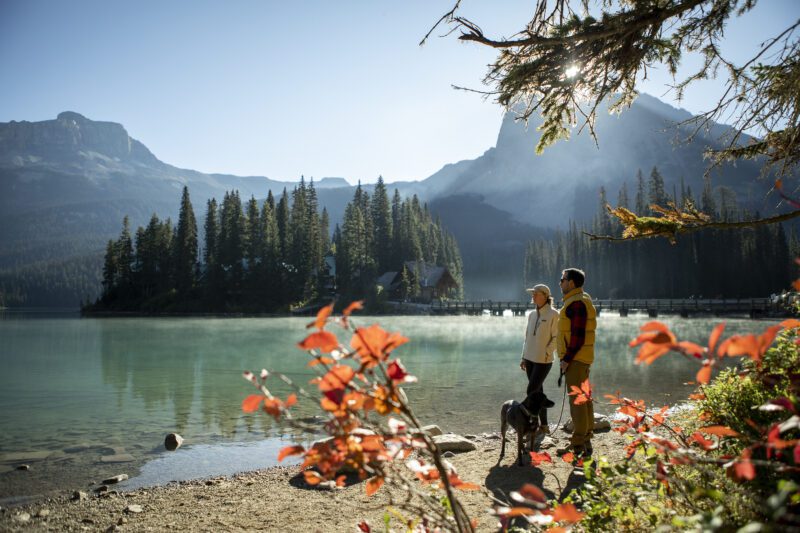
PC: Abby Cooper
3. Keep your pet on a leash at all times – It is against the law to have your pet off-leash in a national park and some trails aren’t pet-friendly. While we are certain your pooch pal is well-behaved, some animals act unpredictably in new situations. Off-leash dogs can trigger aggressive behaviour from wildlife such as grizzly bears and elk, or harm smaller animals. Keep your pet AND wildlife safe by knowing where they are welcome and keeping them on leash and under control.
4. Give wildlife space – Seeing a wild animal in its natural habitat is one of the most special encounters you can have! Keep wildlife wild by making noise on trails, carrying bear spray, and giving lots of space when on the trail. When traveling in your car, be sure to obey the speed limit as animals can often run across the highway. If you see an animal pull completely off the road, take a quick photo and move on. Most importantly stay in your vehicle
5. Leave no trace - Did you know? It is actually illegal to collect plants, mushrooms, berries, animals, animal parts (including antlers), fossils, driftwood, rocks, and other historical or natural objects. Leave with nothing but memories (and a bunch of great photos of course). This also applies to staying on the trail. Off-trail use can damage sensitive plants and erode soil.
6. Avoid restricted areas – occasionally trails can be closed for construction or to keep wildlife and visitors safe. Always come with a backup plan for your hike or picnic area. If an area you plan to visit is closed, please come back another day.
7. No drone zone - It's true, nobody is allowed to fly a drone in a national park without a special exemption. But don't take it too personally — flying any aircraft in a national or provincial park is prohibited, and drones just happen to fall into that category. So please leave your helicopters gliders and jets at home as well.
We think this place is pretty special and we know you will agree. Thank you for helping to protect this special place and keep it wild for all to enjoy.
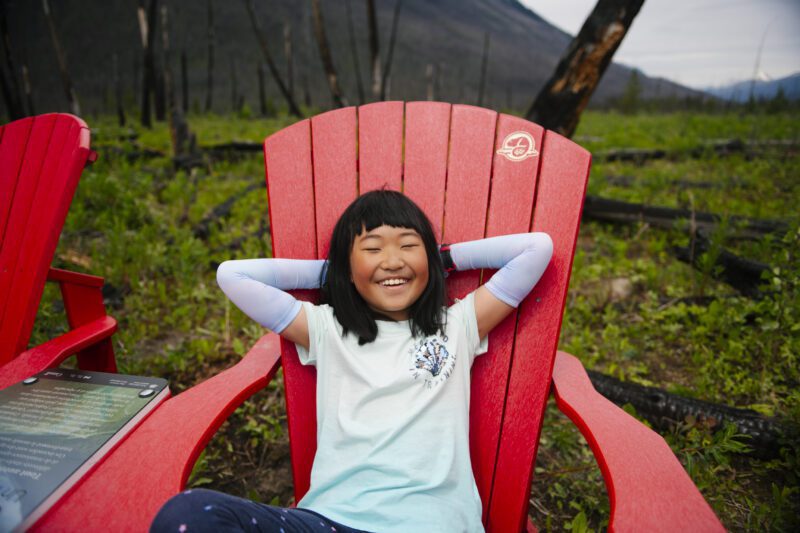
Plan Your Trip to the Village of Radium!
Whether you have allocated a few days to explore the Village or an action-packed afternoon along your Golden Triangle road trip, there are some must-see spots in Radium Hot Springs! Make the most of your trip and be sure to include time for the must-see attractions.
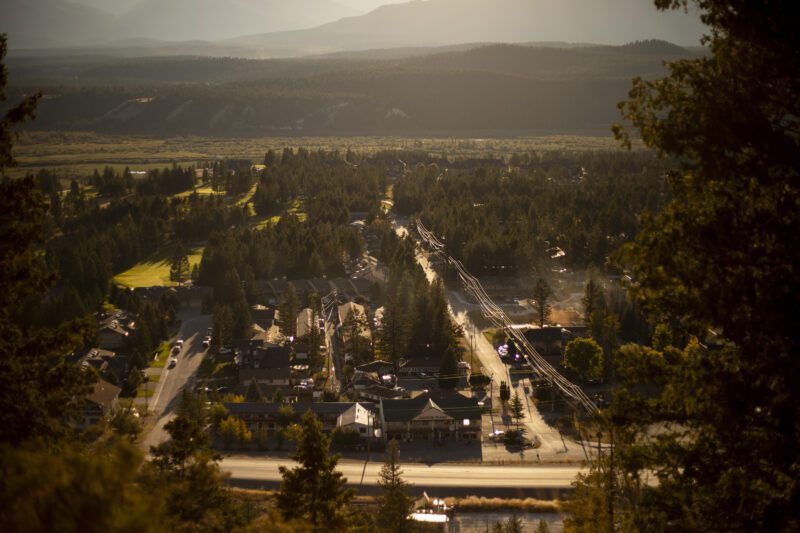 Take in Nature
Calling all bird lovers! Did you know? Radium Hot Springs is an ideal place to bird-watch. A great place to start is at the Old Coach Trail, overlooking the beautiful Purcell Mountains and the Columbia River Wetlands. The Wetlands are home to over 267 species of birds and many other types of mammals, insects, amphibians, and fish. Those visiting Radium will also love to see the iconic Bighorn Sheep roaming the Village, spotted most frequently in the autumn.
Soak in the Hot Springs
Stop in for a soak at the namesake Radium Hot Springs pools! Bring your own towel and bathing suit, or rent some at the entrance. Plan for a few hours to soak in the relaxing thermally heated, odorless mineral waters of the Hot Springs pools.
Radium Hot Springs pools operating information >
Take in Nature
Calling all bird lovers! Did you know? Radium Hot Springs is an ideal place to bird-watch. A great place to start is at the Old Coach Trail, overlooking the beautiful Purcell Mountains and the Columbia River Wetlands. The Wetlands are home to over 267 species of birds and many other types of mammals, insects, amphibians, and fish. Those visiting Radium will also love to see the iconic Bighorn Sheep roaming the Village, spotted most frequently in the autumn.
Soak in the Hot Springs
Stop in for a soak at the namesake Radium Hot Springs pools! Bring your own towel and bathing suit, or rent some at the entrance. Plan for a few hours to soak in the relaxing thermally heated, odorless mineral waters of the Hot Springs pools.
Radium Hot Springs pools operating information >
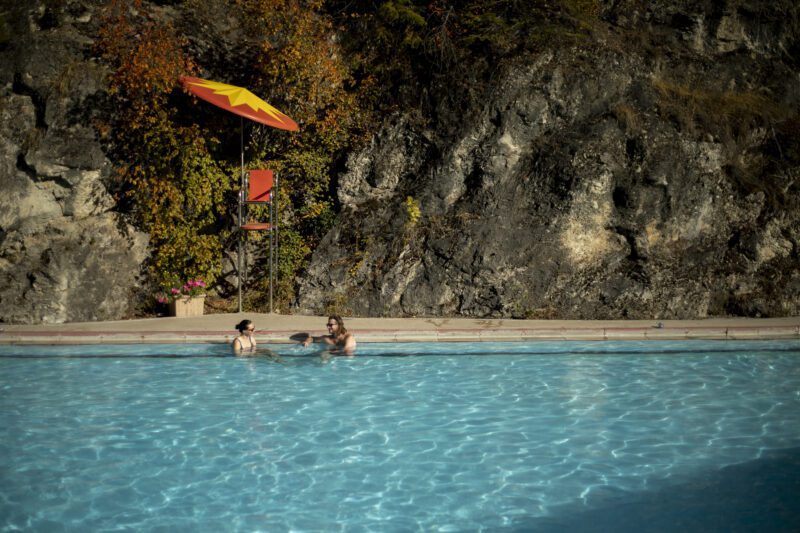 Hike the Trails
Whether you’re looking for an all-day adventure or an after-dinner stroll, the trails in and around Radium Hot Springs have got you covered.
Hiking in Radium >
Explore Main Street
Peruse the local shops and activities of Main Street in Radium Hot Springs. Pick up a sweet treat at the candy shop or peruse local artisans.
Hike the Trails
Whether you’re looking for an all-day adventure or an after-dinner stroll, the trails in and around Radium Hot Springs have got you covered.
Hiking in Radium >
Explore Main Street
Peruse the local shops and activities of Main Street in Radium Hot Springs. Pick up a sweet treat at the candy shop or peruse local artisans.
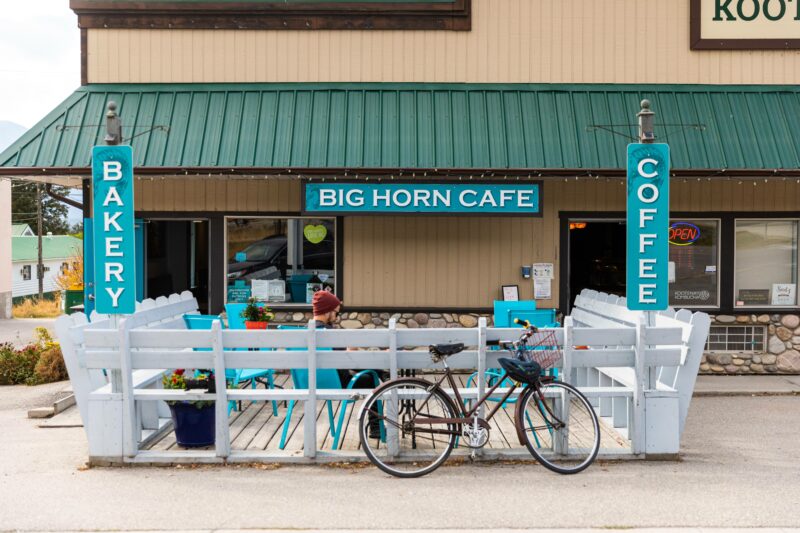 Stop at the Sinclair Canyon
Take in the Sinclair Canyon, the magnificent entrance to Radium Hot Springs from Kootenay National Park, for a great view and photo opportunities. Hikers can continue on the trails up to the top of the canyon, or down to the Sinclair Falls.
Visit the Visitor Centre
Your adventure starts at the Radium Visitor Centre! Stop by for intel on the best things to do and places to see, according to locals. Pick up any maps, activity suggestions, and information you may need at the Visitor Centre, open daily from 9 a.m. - 5 p.m. While you’re there, make sure to visit the interpretive displays to learn more about wildlife and the Ktunaxa people.
Visitor Centre Hours & Location >
Take in the Views
There are many scenic spots and pullouts to check out in Radium! From the roadside pullouts on Highway 93/95 (just south of Radium Hot Springs) overlooking the Columbia River Wetlands to the bright green Olive Lake in Kootenay National Park to the birds-eye view of town at the Valley View Lookout, you don’t have to travel far to earn good views.
Stop at the Sinclair Canyon
Take in the Sinclair Canyon, the magnificent entrance to Radium Hot Springs from Kootenay National Park, for a great view and photo opportunities. Hikers can continue on the trails up to the top of the canyon, or down to the Sinclair Falls.
Visit the Visitor Centre
Your adventure starts at the Radium Visitor Centre! Stop by for intel on the best things to do and places to see, according to locals. Pick up any maps, activity suggestions, and information you may need at the Visitor Centre, open daily from 9 a.m. - 5 p.m. While you’re there, make sure to visit the interpretive displays to learn more about wildlife and the Ktunaxa people.
Visitor Centre Hours & Location >
Take in the Views
There are many scenic spots and pullouts to check out in Radium! From the roadside pullouts on Highway 93/95 (just south of Radium Hot Springs) overlooking the Columbia River Wetlands to the bright green Olive Lake in Kootenay National Park to the birds-eye view of town at the Valley View Lookout, you don’t have to travel far to earn good views.
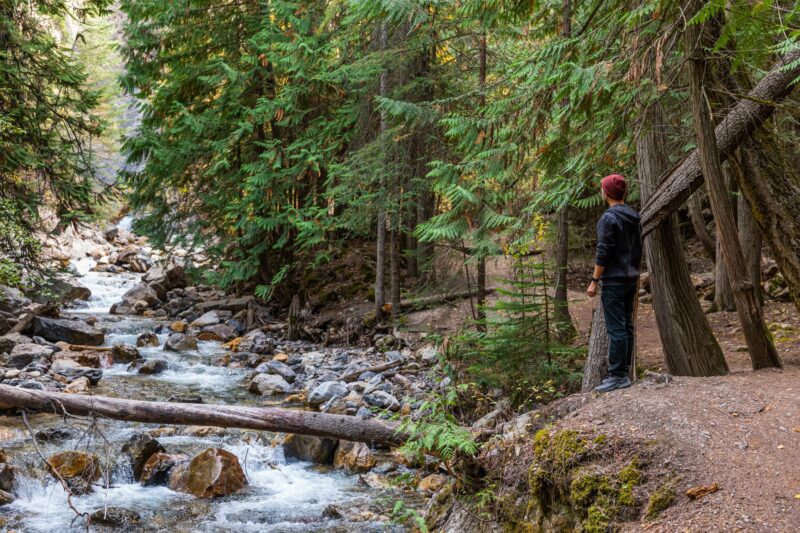 Grab a Bite
Stop in at one of the tasty local restaurants in Radium Hot Springs. Known for local and fresh food, you’ll find a surprising variety of great choices in the charming town.
View all of the restaurants in Radium Hot Springs and make your choice >
Find Your Adventure
Are you ready to raft down the beautifully scenic Kootenay River? Looking to test your skills in an escape room, fly high on a zipline course, or head out on an interpretive guided hike? There are so many activities and adventures in Radium Hot Springs! Find your fit and invite your crew along for an unforgettable experience.
Explore Activities & Adventures in Radium Hot Springs >
Grab a Bite
Stop in at one of the tasty local restaurants in Radium Hot Springs. Known for local and fresh food, you’ll find a surprising variety of great choices in the charming town.
View all of the restaurants in Radium Hot Springs and make your choice >
Find Your Adventure
Are you ready to raft down the beautifully scenic Kootenay River? Looking to test your skills in an escape room, fly high on a zipline course, or head out on an interpretive guided hike? There are so many activities and adventures in Radium Hot Springs! Find your fit and invite your crew along for an unforgettable experience.
Explore Activities & Adventures in Radium Hot Springs >
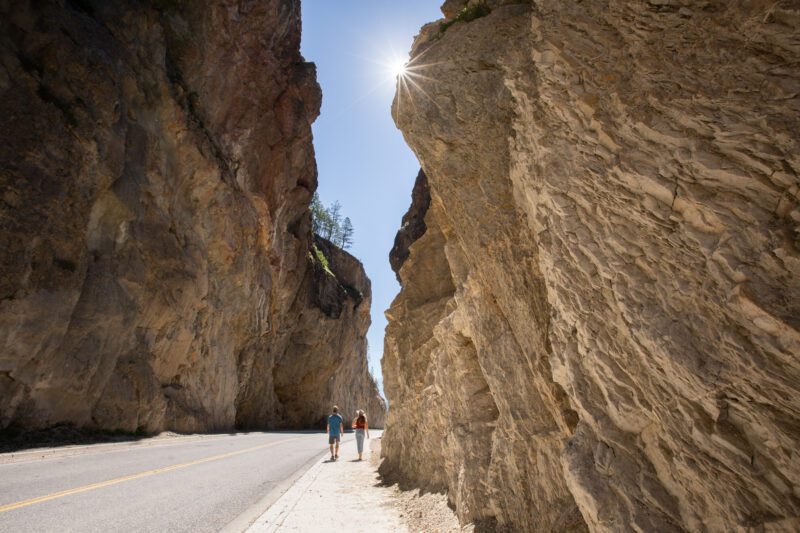 Settle in for a Stay
Find the best place to stay in Radium Hot Springs! With a diverse range of places to stay, check out options ranging from affordable to luxurious. Stay within walking distance to local restaurants and shops, or tuck away to a quiet cabin surrounded by nature.
Explore Places to Stay >
There’s so much to see and do in Radium Hot Springs! Extend your trip for a few days by taking on the Golden Triangle Road Trip to explore the other side of the Rockies. Gain iconic views of the Rockies in two National Parks: Kootenay and Yoho. And spend time in the charming mountain towns of Radium Hot Springs and Golden.
Settle in for a Stay
Find the best place to stay in Radium Hot Springs! With a diverse range of places to stay, check out options ranging from affordable to luxurious. Stay within walking distance to local restaurants and shops, or tuck away to a quiet cabin surrounded by nature.
Explore Places to Stay >
There’s so much to see and do in Radium Hot Springs! Extend your trip for a few days by taking on the Golden Triangle Road Trip to explore the other side of the Rockies. Gain iconic views of the Rockies in two National Parks: Kootenay and Yoho. And spend time in the charming mountain towns of Radium Hot Springs and Golden.
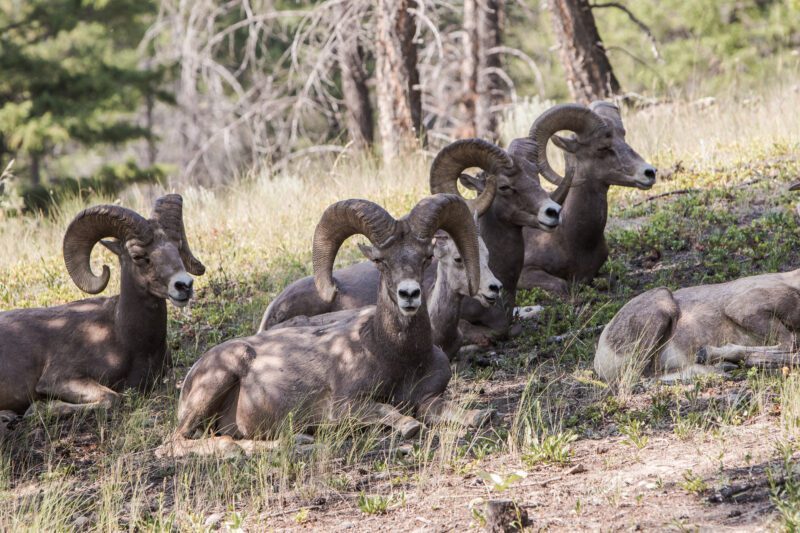
Family Fun in the Fall
Your kids are going to love this route! It’s one of my favourites – because well, I’m a kid at heart. The Golden Triangle three-day route has you standing at the base of towering waterfalls, taking short hikes to awesome sites and interesting geological formations, stopping at spectacular viewpoints and screaming with delight at an outdoor adventure park. Sure, you can do it in the summer, but in the fall, there are less crowds and a magnificent display of autumn foliage. Pack the overnight bags – it’s going to get bumpy.
Yoho National Park showers you with splendor
I’m serious on the shower. There is a short relatively flat hike to the base of the 373-metre tall Takakkaw Falls. Enjoy the view from the brilliant red Parks Canada chairs, or follow the kids as they dash across the bridge towards the base of the falls. The water flows from the Daly Glacier, to drop and bounce for that final freefall of 254 metres. In July when the water shoots like a firehose, the spray drifts across the trees and anyone standing at the base gets soaked. In the fall however, the flow is diminished, the thunder of the waterfall is slightly less deafening, and the rocks are easier to wander through to the base. It really is magnificent.
Now that you have seen a waterfall from the bottom up, take a short drive to the Natural Bridge on the road to Emerald Lake to see that same flow of water cascades through a hole sculpted in the bedrock as it continues its journey to the coast. There are vantage points to see the feature near the parking lot but take the kids a bit further to see the water come gushing through the hole. All it took was a few million years for the water to erode through a layer of soft sediment, but you can see it all in less than an hour. Continue on the road to Emerald Lake for an easy walk around the shore or explore further on the rugged trails. Rent a canoe to dip a paddle in the beautiful teal blue waters.
Golden shines with family activities
Remember I said I was a kid at heart? The new Golden Sky Bridge attraction makes me giddy like a kid in a playground. Two of Canada’s highest suspension bridges draped 130 metres (426 ft) above the expansive canyon and waterfall. Yes, that’s cool but even better is the new Canyon Edge Challenge. Three different courses test your balance, nerve and ability on ladders, bridges, and ropes. It’s great for the whole family.
In the town of Golden, take a break and wander the new River Walk alongside the Kicking Horse River. Include a walk across the Kicking Horse Pedestrian bridge. It’s the longest freestanding timber frame bridge in Canada. Stop in at the nearby sports and recreation shop to rent some gear to try disc golfings. If you can throw a Frisbee you can play disc golf at the course in Golden.
Have you met Boo yet? He is the grizzly bear living at the Grizzly Bear Interpretive Centre at Kicking Horse Mountain Resort. I met him last summer and was amazed at how much I learned on my tour. Of course, he was on the other side of a fence but getting up close to a grizzly and learning about the species is a bucket list adventure for any age.
Wetlands to Hot Springs – it’s Radium
The Columbia River Wetlands stretching from Golden to Radium Hot Springs is a perfect area to slow down and play “Spot the wildlife.” More than 216 species of birds, fish, reptiles, amphibians, and mammals all use this valley. Rent a few kayaks or paddleboards and drop them in the river to let the current take you on a journey. If you silently slip along with the current, the birds and shore species are less likely to flee too quickly. Last time we were through we saw a few Great Blue Herons. If you don’t like the option of getting wet, the 9-km long Old Coach Trail overlooks the wetlands and is perfect for hiking or biking. Considering it was first constructed in the 1920s for Model T cars, you know it will be easy.
If the kids are game for a few hours on a pretty hike, tempt them with the Sinclair Canyon Trail. It offers opportunities to see Sinclair Falls and the narrow canyon. The best part about this trail is that it ends in the Radium Hot Springs parking lot. Did you bring your swimsuit? Don’t worry if you didn’t. Parks Canada has some retro suits you can rent. After a day on the trail or paddling the waterways, a soak in the mineral rich hot water is appreciated by any age.
In Radium, you’ll see the resident Bighorn Sheep wandering through town. Always keep your distance. Those horns mean business. See if the kids want to tour the town and nearby trails on a Segway.
Travelling along highway 93 there are a few perfect spots to let the kids out to explore the colours. Olive Lake boardwalk is super short. The kids will love how the lake changes colours with the light. The trees will be putting on a brilliant orange and red show too. Further along is Marble Canyon. In the summer, the short trail to see the emerald-blue glacier-fed stream tumble through the gorge can be crowded, but in the fall, you’ve got the trail to yourself.
Nichées dans le canyon Sinclair, ces piscines d’eau minérale spacieuses sont depuis plus d’un siècle une halte prisée des voyageurs qui traversent les Rocheuses canadiennes en voiture.
Foulez le sol de deux provinces en même temps, avant de partir en promenade dans une forêt tranquille et ombragée!
La ligne continentale de partage des eaux sépare deux bassins hydrographiques, deux provinces et deux parcs nationaux.
Cherchez des épilobes fuchsia dans un paysage façonné par le feu, l’érosion et le processus de formation des montagnes.
De multiples ponts enjambent la gorge étroite. Zigzaguez au-dessus du précipice tout en jetant des coups d’œil à la rivière en contrebas. Frissons garantis!
Saisissez dans vos mains un fragment de l’histoire de la Terre au cours de cette randonnée guidée. Découvrez de quelle manière le feu a aidé les scientifiques à trouver de nouveaux gisements de fossiles. Réservations obligatoires.
Cette promenade facile vous mène à trois sources minérales riches en fer qui tachent d’orangé le sol environnant.
Excellente destination pour une promenade en raquettes en hiver.
Traversez deux ponts qui enjambent la rivière Kootenay et serpentez à travers une vieille forêt.
Terminez votre randonnée au bord d’un lac endormi au pied de magnifiques montagnes.
Étendez une couverture de pique-nique et profitez d’un moment de détente ou rendez-vous à la rivière Kootenay pour une partie de pêche ou une sortie en canot.
Une aire de pique-nique boisée au sommet du col Sinclair, près d’un lac émeraude vif.
Cherchez des ombles de fontaine tout en faisant le tour du lac sur le trottoir de bois.
Les hautes parois rouges du canyon Sinclair forment l’une des portes d’entrée les plus impressionnantes de tous les parcs nationaux du Canada.
Elles sont sans doute aussi l’une des caractéristiques les plus célèbres du parc national Kootenay.
 Strap on your hiking boots! Visiting one of Canada’s national parks is a thrilling adventure whether it is your first or your one hundredth visit. The spectacular wilderness, awe-inspiring views, and jewel-toned lakes of the mountain national parks draw millions of visitors every year.
Like any trip, advanced planning will set you up for success and help you tick off those bucket list items with ease. So, let’s talk about what you need to know when touring the Golden Triangle and visiting the mountain national parks.
A national park. What does that mean?
Along your journey through the Golden Triangle, you will pass through 3 separate and unique national parks. Yoho, Kootenay and Banff. Long before park designation, these lands and waters were the traditional territories of Indigenous groups such as the Ktuxnaxa and Secwépemc Nations who stewarded these places.
Starting as early as 1885, park lands were established to preserve and protect the unique and spectacular mountain wilderness so that the landscapes can be enjoyed long into the future. In Canada, national parks are protected under the Canada National Parks Act. The primary goal of Parks Canada is to protect the ecological integrity of the land and waters while allowing visitors to explore, learn, and connect with natural spaces in unique regions across Canada.
What does this all mean? It means, these places are special, and there are certain rules you are expected to know and follow when visiting here that will help protect the incredible wildlife and the unique environment.
Strap on your hiking boots! Visiting one of Canada’s national parks is a thrilling adventure whether it is your first or your one hundredth visit. The spectacular wilderness, awe-inspiring views, and jewel-toned lakes of the mountain national parks draw millions of visitors every year.
Like any trip, advanced planning will set you up for success and help you tick off those bucket list items with ease. So, let’s talk about what you need to know when touring the Golden Triangle and visiting the mountain national parks.
A national park. What does that mean?
Along your journey through the Golden Triangle, you will pass through 3 separate and unique national parks. Yoho, Kootenay and Banff. Long before park designation, these lands and waters were the traditional territories of Indigenous groups such as the Ktuxnaxa and Secwépemc Nations who stewarded these places.
Starting as early as 1885, park lands were established to preserve and protect the unique and spectacular mountain wilderness so that the landscapes can be enjoyed long into the future. In Canada, national parks are protected under the Canada National Parks Act. The primary goal of Parks Canada is to protect the ecological integrity of the land and waters while allowing visitors to explore, learn, and connect with natural spaces in unique regions across Canada.
What does this all mean? It means, these places are special, and there are certain rules you are expected to know and follow when visiting here that will help protect the incredible wildlife and the unique environment.
 Know before you go.
When considering a visit to the other side of the Rockies, knowing where to go and how to behave will help you maximize your time here and prevent some common pitfalls. Here are some some of our top tips:
Get your Pass: To keep it simple, all visitors to a National Park in Canada must have either a National Park Day Pass, or an annual pass known as a “Discovery Pass”. Admission fees help maintain these places and allow amenities (like interpretive signage and trails) to stay in good repair. A day pass is good for the day you purchased it until 4 p.m. the next day. A discovery pass provides you with unlimited admission to all participating national parks, national marine conservation areas and national historic sites and it is valid for 12 months from the date of purchase! If you will be visiting Parks Canada places for more than 7 days this year, the discovery pass is worth the cost. When touring the Golden Triangle, you can purchase your Parks pass at:
Know before you go.
When considering a visit to the other side of the Rockies, knowing where to go and how to behave will help you maximize your time here and prevent some common pitfalls. Here are some some of our top tips:
Get your Pass: To keep it simple, all visitors to a National Park in Canada must have either a National Park Day Pass, or an annual pass known as a “Discovery Pass”. Admission fees help maintain these places and allow amenities (like interpretive signage and trails) to stay in good repair. A day pass is good for the day you purchased it until 4 p.m. the next day. A discovery pass provides you with unlimited admission to all participating national parks, national marine conservation areas and national historic sites and it is valid for 12 months from the date of purchase! If you will be visiting Parks Canada places for more than 7 days this year, the discovery pass is worth the cost. When touring the Golden Triangle, you can purchase your Parks pass at:
 Reserve in advance.
These special places are extremely popular in the summer months (May – October). Access to most trails and day-use areas are first-come first-serve and parking areas can fill quickly. To create some certainty in your trip we recommend booking campsites and guided experiences with as much notice as possible. The Parks Canada Reservation Service is your one-stop shop for front-country and backcountry campsites, glamping accommodations like oTENTiks, and day-use tickets for guided hikes and transit (where offered). Reservations open in January or February most years and are in high demand. Can’t find what you’re looking for? Check back often as cancellations can happen. Also, most locations do have some first-come first-served spots and there are additional accommodators in the Village of Radium, the Town of Golden, and the community of Field.
Closer to your trip, be sure to check the Parks Canada website or contact the Visitor Information Center to find out what locations are open, what conditions to expect, how to prepare, and what services are available before you travel. This will help you select activities that fit your level of skill and knowledge, what gear will be required for your trip, and what accessible options and accommodations are available throughout the park.
Visitor guidelines you might not know about.
We’ve already mentioned this place is special and we need your help to keep it this way. Yoho, Kootenay, and Banff national parks are home to hundreds of species, including grizzly bears, wolves, elk, and more (not to mention all the birds, fish, reptiles, and insects). These animals rely on the unique ecosystem for their survival so protecting it should be a top priority. Here are some things you may not think about when visiting a national park that are extremely important:
Reserve in advance.
These special places are extremely popular in the summer months (May – October). Access to most trails and day-use areas are first-come first-serve and parking areas can fill quickly. To create some certainty in your trip we recommend booking campsites and guided experiences with as much notice as possible. The Parks Canada Reservation Service is your one-stop shop for front-country and backcountry campsites, glamping accommodations like oTENTiks, and day-use tickets for guided hikes and transit (where offered). Reservations open in January or February most years and are in high demand. Can’t find what you’re looking for? Check back often as cancellations can happen. Also, most locations do have some first-come first-served spots and there are additional accommodators in the Village of Radium, the Town of Golden, and the community of Field.
Closer to your trip, be sure to check the Parks Canada website or contact the Visitor Information Center to find out what locations are open, what conditions to expect, how to prepare, and what services are available before you travel. This will help you select activities that fit your level of skill and knowledge, what gear will be required for your trip, and what accessible options and accommodations are available throughout the park.
Visitor guidelines you might not know about.
We’ve already mentioned this place is special and we need your help to keep it this way. Yoho, Kootenay, and Banff national parks are home to hundreds of species, including grizzly bears, wolves, elk, and more (not to mention all the birds, fish, reptiles, and insects). These animals rely on the unique ecosystem for their survival so protecting it should be a top priority. Here are some things you may not think about when visiting a national park that are extremely important:




 Take in Nature
Take in Nature
 Hike the Trails
Hike the Trails
 Stop at the Sinclair Canyon
Stop at the Sinclair Canyon
 Grab a Bite
Grab a Bite
 Settle in for a Stay
Settle in for a Stay

